A Prelude to ‘Not Yet Not Yet Complete’
An Interview with Ai Weiwei in Five Parts
by Ian Boyden
For nearly a century, Communist regimes have employed damnatio memoriae, literally ‘condemnation of memory’, to deal with the ever changing terrain of history. Memory holes are opened up for the disposal of nettlesome individuals whose existence threatens to besmirch the public record. It is in this way that, while the future holds out a promise of an unchanging utopia, the past constantly undergoes revision.
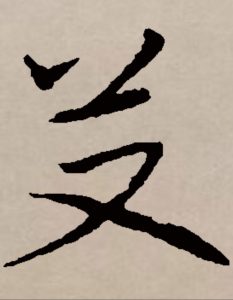
Under Xi Jinping, head of the party-state-army of China’s People’s Republic, the country’s memory hole industry has enjoyed a new boom. It is an enterprise devoted to the obliteration of the images, memories and works of individuals deemed to be persona non grata. China’s memory holes are generously engineered to disappear ideas, events and even discomfiting eras. They gobble up dissidents and their writings; they also devour the enemies within, men and women purged for real or concocted crimes against the Party. Moreover, from 2017, the international academic industry also learned that some of their publishers were collaborating in the memory hole industry by deleting research work that was displeasing to the Communist authorities from the online journals and books that they ‘sold into’ the mainland Chinese market (see Burn the Books, Bury the Scholars!, China Heritage, 22 August 2017).
In 2018, the momentary disappearance of the celebrity Fan Bingbing, who resurfaced as a penitent tax cheat, and the president of Interpol, Meng Hongwei, a faithful Communist Party man, led to global unease. Now, only the most willfully upbeat fellow travellers could ignore the gaping maw of China’s memory holes and what they portend.
In May 2017, on the eve of the Double Five Festival 端陽節 of the Chinese lunar calendar, China Heritage published Memory Holes, Old & New. It featured an essay written in 1987 about learning to live with the memory holes of the Deng Xiaoping era. These gaps in the public record were created in the wake of the fall from power of Party General Secretary Hu Yaobang for relative liberalism, and the purge from the Party of three popular public figures: the astrophysicist Fang Lizhi 方勵之, the journalist Liu Binyan 劉賓雁 and the writer Wang Ruowang 王若望. Later in 1987, the playwright Wu Zuguang 吳祖光 was politely but firmly requested to join that disgraced trio for having launched a fusillade of anti-Party statements (for details, see The Party Empire, China Heritage, 17 August 2018).
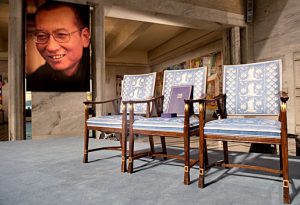
Following the fitful events of 1987, the Party’s memory hole industry took centre stage following 4 June 1989. The dramatic events related to the student-led protests that year, and the Beijing Massacre of June (as well as the violent repression of protesters in dozens of other cities) were either obliterated from memory, or so heavily censored and rewritten as to be unrecognisable. Since then, the industry has experienced both bursts of growth and relative stasis. For a time, its operation was symbolised internationally by the empty chair set up on the dais of December 2010 Nobel Peace Prize award ceremony for the absent dissident Liu Xiaobo 劉曉波. (Liu had been detained in late 2008 and was subsequently given a lengthy jail sentence on trumped up charges of subversion. In July 2017, he died in custody, murdered-by-state-neglect.)
Then, in April the following year, the celebrated artist and writer Ai Weiwei was detained at Beijing International Airport. During his absence from public view, the official Chinese media trounced his reputation and his work (see A View on Ai Weiwei’s Exit, June 2011). Eventually released and finally allowed to travel overseas, Ai Weiwei has continued his long slide into China’s memory hole. Now, not only his reputation in China, but his work, and his art studios both in Shanghai and Beijing have been expunged from the country’s public life. His indelible place in modern Chinese cultural history added to by his global celebrity, irrepressible creativity, and the long-tail of his electronic presence means that Weiwei is someone the Chinese party-state can never definitively ‘disappear’.
We celebrate Ai Weiwei by publishing ‘Not Yet Not Yet Complete’, an interview conducted by Ian Boyden, another artist, writer and a translator whose work has previously featured in our pages (see A Forest of Names — the translation of one grief to another, China Heritage, 24 April 2018). We are honoured that Weiwei and Ian have agreed to us publishing this important dialogue and we do so not only to applaud Ai Weiwei’s defiance of memory holes, be they in China or elsewhere, but also in memory of Ai Qing.
— Geremie R. Barmé
China Heritage
18 October 2018
***
Not Yet Not Yet Complete
An Interview with
Ai Weiwei
by Ian Boyden
Contents
- The Editor, China Heritage, A Prelude: An Afternoon in Beijing, September 1978, China Heritage, 18 October 2018
- Ian Boyden, Introduction, and Ai Weiwei & Ian Boyden, Part I: In the Consequences of Poetry, China Heritage, 20 October 2018
- Ai Weiwei & Ian Boyden, Part II: The Prison of a Name, China Heritage, 22 October 2018
- Ai Weiwei & Ian Boyden, Part III: Exile and the Consequences of Hope, China Heritage, 24 October 2018
- Ai Weiwei & Ian Boyden, Part IV: Automatic Writing and the Spilling of Blood, China Heritage, 26 October 2018
- Ai Weiwei & Ian Boyden, Part V: The Conditions of Empathy, China Heritage, 28 October 2018
Note: This material is collected in The Best China section of China Heritage. — Ed.
Prelude to an Afternoon
Four decades ago, I experienced an exhilarating moment in Chinese history when decades-old memory holes suddenly disgorged some of their contents. In September 1978, my friend the translator Gladys Yang suggested that we visit Ai Qing and his wife Gao Ying 高瑛. Ai Qing (艾青, Jiang Haicheng 蔣海澄, 1910-1996) had first been denounced during the Yan’an Rectification Campaign and, although a loyal member of the Communist Party who managed to redeem himself, he again fell foul of the cultural bosses in the 1950s. The ignominy continued until after Mao Zedong’s death in 1976. Gladys had received word that, although Ai Qing and his family had been allowed to return to Beijing a few years earlier, it was only now convenient for them to entertain visitors like Gladys, people who, like them, had been cast into the shadows.
As an exchange student at Liaoning University in Shenyang in 1975-1976, we had classes devoted to ‘the two-line struggle on the literature and arts battle front’ 文藝戰線兩條路線鬥爭 (this followed on from a year at Fudan University in Shanghai where the main subjects had been carefully selected works of Lu Xun, Revolutionary Model Operas and Maoist dialectics). Apart from being inducted into the correct thinking provided by Marxist-Leninist-Stalinist-Maoist classics, we were also to be inoculated against the wrong ideas by reading selections from writers like Ai Qing. Along with other notorious Yan’an-era cultural figures like Wang Shiwei (王實味, 1906-1947) and Ding Ling (丁玲, 1904-1986), Ai was a ‘negative example’ 反面教員; our textbooks provided only scant excerpts of their work, ‘poisonous weeds’ 毒草 or ‘negative materials for denunciation only’ 供批判用的反面材料, along with lengthy critiques of how their writing corrupted the young and undermined the revolution.
We learned that during the ‘Second Denunciation’ 再批判 of these writers (and a number of others), launched in January 1958 following the Anti-Rightist Campaign, Mao sarcastically thanked them for producing poisonous weeds that, as he put it ‘have become fertiliser; they educate the broad masses of Chinese people, for they demonstrate the enemy’s plots. The stench of such work unblocks people’s noses, it makes our romantic and detached youth, as well as older people, understand many, many things.’ A lengthy attack on Ai Qing written by a twenty-seven-year-old Shanghai critic by the name of Yao Wenyuan (姚文元, 1931-2005) was published, and the poet himself disappeared. (In late 1965, Yao achieved further national fame for his denunciation of a play about Hai Rui 海瑞, a Ming-dynasty official, that Mao used to launch the Cultural Revolution. Put in charge of Party propaganda in 1970, Yao’s star only faded with the death of Mao, when he was arrested as a member of the ‘Gang of Four’ and tried for his role in the ‘Lin Biao-Jiang Qing Anti-Party Clique’.)
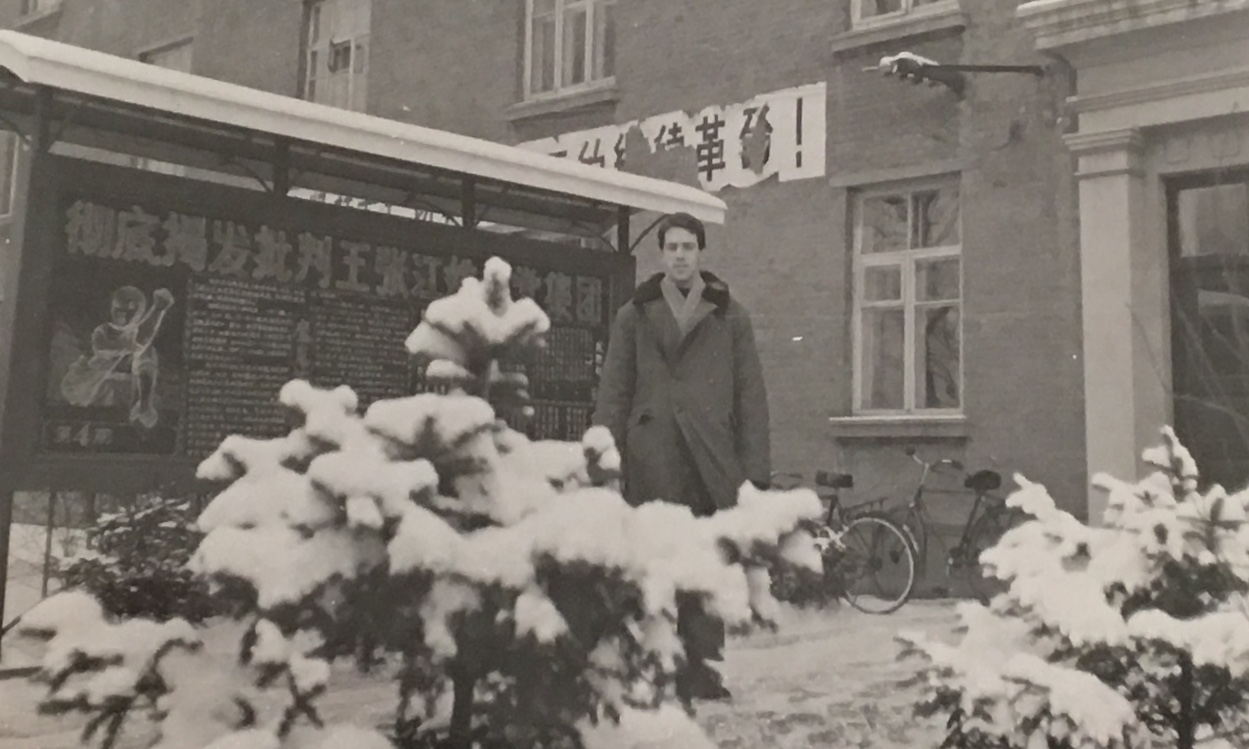
By 1978, generations of writers, along with long-lost political figures, war heroes, intellectuals and once-prominent individuals, were reappearing, initially only in fits and starts and then in breathtaking cascade. After an absence of years if not decades, some were interviewed in the media or allowed to publish new works; others, long since dead, were commemorated at official funerals. In August-September 1978, I was in Beijing visiting the Yangs and other friends.
With Mao long dead and his main followers purged and jailed, the dogmas of the last two decades were being challenged. In May 1978, Hu Fuming 胡福明, an academic at Nanking University, had published a long theoretical essay titled ‘Practice is the Sole Criterion of Truth’ with the support of Party leaders. It was a direct challenge to many of the ossified Stalinist-Maoist ideas that had developed since the Yan’an era of the 1940s. Then, in early August, Wenhui Bao 文匯報, the main Shanghai daily newspaper, published a short story by Lu Xinhua 盧新華, a student at Fudan University titled ‘Scars’ 傷痕. It caused a sensation and led to a wave of cultural works that dwelled on the damaged hearts and minds left in the wake of the Cultural Revolution. (Back in Hong Kong, where I was one of the English editors at a Chinese-language magazine The Seventies Monthly 七十年代月刊, edited by Lee Yee 李怡 — now an author featured in China Heritage — my colleague Bennett Lee and I translated ‘Scars’ and other stories which were published by Sanlian Books in 1979 as The Wounded, the first selection of post-Mao fiction.) And, an otherwise undistinguished wall at the Xidan intersection of Chang’an Avenue became the venue for protesters to put up posters attacking many aspects of Party policy. On trips to Beijing over the following months, I would spend many hours copying down posters and talking to their authors.
By late 1979, or ‘Democracy Wall’ as it was known, was shut down, the samizdat publications it had helped launch and its most famous protester, Wei Jingsheng (魏京生, 1950-), detained. Wei was arraigned in court accused of having leaked state secrets and for nebulous ‘counter-revolutionary crimes’. Not long thereafter, Yao Wenyuan, Ai Qing’s nemesis, would also find himself cast into the memory hole: after a trial spanning December 1980 to January 1981, Yao was sentenced to twenty years for two decades of ideological mayhem; Wei Jingsheng got fifteen because he crossed Deng Xiaoping and called for democracy in China. This was also how Deng Xiaoping’s vaunted ‘new era’ 新時期 began.
***
Forty years later, it may be difficult for readers to appreciate how effective the Communists were at ‘disappearing’ many of China’s most famous writers, artists, scientists and public figures, not just for a few, days, weeks or months, but for decades. There were no easy sources of information, no record of the damned, merely rumour and speculation. There was simply a deadening silence, until the Party decided that there wasn’t.
I lived in China and Hong Kong as the Party’s memory hole gradually disgorged many of these lost souls, sometimes in person — as in the case of Ai Qing — but also frequently, and tragically, merely by reputation, or during memorial services. On Gladys’s introduction I also met Ding Ling, although it was not until 1986, when the investigative journalist Dai Qing (戴晴, 1941-) published her magisterial study of ‘Wild Lilies’ 野百合花 and its author, that we learned that Wang Shiwei had been beheaded on the orders of a Party leader in 1947. (In 1989, Dai Qing’s revelations about the long dead editor and journalist Chu Anping 儲安平 would also shock readers who naïvely thought that the Party’s memory holes held no more secrets.)
So, for those of us of a certain vintage (if we have been paying attention), the lived experience of China has been not only about the present but also about living with the repeated reappearance, reappraisal and, sometimes, disappearance of the past. I first encountered Ai Qing when he was a non-person, and his lifework ‘poisonous weeds’. When we met in person he generously offered his time and friendship to me as a fledgling translator and writer on Chinese culture. Soon he was a celebrity. I also met his son, Ai Weiwei, a member of a generation of cultural talents that appeared in the late 1970s. Twenty years later, during his New York years, he let me use one of his works in a book on contemporary Chinese culture.
Over the past decade, although the Chinese party-state has made repeated efforts to silence and vilify him as they did his father, Ai Weiwei’s calm but irrepressible moral outrage, his outspokenness, his constantly evolving art and the power of his words, mean that he simply cannot be ignored. His global reputation and the Internet defy China’s memory hole.
— GRB
Further Reading:
- Wine (jiu 酒) and Commemorating Yang Xianyi 楊憲益, China Heritage Quarterly, No. 25, (March 2011)
- Memory Holes, Old & New, China Heritage, 29 May 2017
- Glenn D. Tiffert, Peering Down the Memory Hole: history, censorship and the digital turn, 21 August 2017
- Burn the Books, Bury the Scholars!, China Heritage, 22 August 2018
- Ian Boyden, A Forest of Names — the translation of one grief to another, China Heritage, 24 April 2018
- Something In The Air — Watching China Watching (XXV), China Heritage, 8 June 2018
- Geremie R. Barmé, One Decent Man, The New York Review of Books, 28 June 2018, vol.64, no.11 — Watching China Watching (XXVI)
- Nicholas Loubere and Ivan Franceschini, How the Chinese Censors Highlight Fundamental Flaws in Academic Publishing, Chinoiresie, 16 October 2018
An Afternoon in Beijing
September, 1978
Geremie Barmé
It was a year since I had been in Beijing, and walking towards Dongdan in the eastern city from Wangfujing, the main shopping thoroughfare nearby, little seemed to have changed. The bus ride from the Western suburbs was definitely the same: slow and crowded. I hadn’t been able to see much of anything when coming in, standing on the bus and hanging on stubbornly to the rail above my head while being buffeted by waves of boarding passengers or stomped on by others pushing and squeezing to get off; I had little desire to bend down and look out of the window.
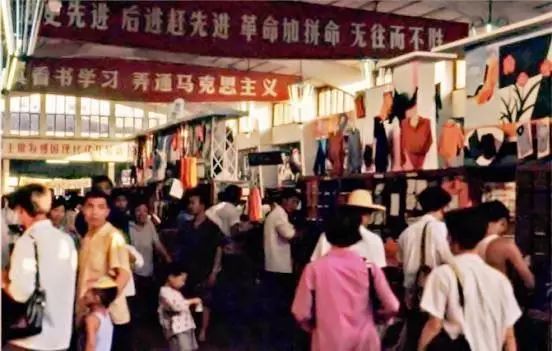
When we got off the bus at the East Wind Market the afternoon heat suddenly hit me. The recent rain may have cleared a little of the incessant Beijing dust, but although it was already autumn it still felt like summer. Crowds of people surged along the footpaths, out-of-city shoppers walking around in awe of the material prosperity of Beijing and the locals, looked very much at home. Although never really my home during the three years that I was a university student in China [from 1974 to 1977], Beijing still remained for me a place of many associations and memories. I must have been there about fifteen times ‘on business’ — the all-purpose, ever-ready excuse of a foreign student wanting a trip to the capital. As a result of all these trips I found that I was more familiar with and comfortable in Beijing than the other cities I had lived in during my stay in China.
The familiar affection with which I spoke of the city, its winding grey lanes and the look of age and mellowing that adorned many of its buildings, both old and new, invited a comment from my friend. She told me that, following 1949, she had lived with her family in a courtyard house in the very street along which we were walking. Despite numerous wanderings in the city and the fact that I knew a number of people who had lived in Beijing for many years, I had never been into one of these courtyard dwellings, or ‘four combination courts’ as they are called in Chinese. Though as characteristic of ‘Old Peking’ as the city gates or the Imperial Palace Museum, courtyard houses have been giving way to modern high-rise apartments since the 1950s.
We soon found ourselves discussing the relative merits of traditional courtyard-style houses, and the concrete and brick ‘boxes’ that have mushroomed in the last three decades. We agreed that the new buildings were the only quick and convenient way of solving the serious housing shortage in Beijing. Nevertheless, these structures and the lack of greenery, parks, adequate transportation and other amenities in the new built-up areas, had created and would continue to create social and environmental problems that planners did not seem to have considered. I cited the recently completed hideous concrete ‘great wall’ of apartment buildings that had been built along the length of the road that marks where the southern face of the city wall used to be [前三門]. Though modern enough in appearance and built in record time, the blocks had obviously been designed with no consideration of the needs of the future inhabitants in mind. Provision of adequate washing facilities in each flat, proximity to transportation, shops, schools, the effect of frequent power cuts on the thirty odd fifteen story monoliths, and many other questions, seemed to have been blissfully ignored. Built perhaps as a sign to the populace that the municipal leadership was actually doing something to solve the enormous problems created by a twelve year hiatus in the development of the city, the new buildings did inevitably show signs of the ‘instant modernization fever’ that is now so widespread in China. My friend ended the conversation with the comment that perhaps the planners would do a better job when the slimy mayor, Wu De, was given the boot! [Original Note: Wu De, Mayor of Beijing from 1967, was linked closely with the excesses of the Cultural Revolution and the suppression of the Tian’anmen lncident protesters but managed to keep his position until late 1978.]
Just as we were talking of the possibilities of a new mayor, we entered an old lane, or hutong as they are called in Beijing. I noticed that the street bore the intriguing name Historians’ Alley [史家胡同]. It turned out to be one of the ‘high-class’ areas of the city — high class in that some higher echelon government officials lived there. We continued along towards the east for a time before Coming to our destination. The blank, grey street-side wall of the houses gave not a hint as to the inner lives and workings of their inhabitants. These houses, perhaps like their makers, betrayed none of the warmth of life in their calm and impersonal appearance.
The battered red gates hung wide open as if yawning after a quiet midday sleep. After climbing the well-worn steps, we went around the stone screen that guarded against both intruding spirits and eyes. and walked down a walled corridor. We had entered the main gate of a compound of courtyards. We stopped at the first door to the left and entered a small court with rooms built on three sides. As we stepped into the courtyard my inquisitiveness about the strange and new world of the ‘four-combination courts’ was forgotten when a man and woman came out of the northern room to meet us. It was the poet and writer Ai Qing and his wife, Gao Ying.
Though familiar to readers and lovers of literature in China for decades, as well as being one of the most often translated modern Chinese poets, Ai Qing’s name had not been mentioned for over twenty years. He, like so many other Chinese intellectuals and writers, had disappeared ‘like a stone thrown into the sea’. To think of reading a recent poem by him, much less actually to have a chance to meet him, would have been no more than a dream, even a year ago. Yet now some of his poems were beginning to be published and friends dared to have contact with him again.
Neighbours in the courtyard busy washing clothes or tending their miniature gardens and cactuses, threw interested and baffled glances at our little group as we went into the poet’s house. So much for privacy, I thought; not the most conducive atmosphere for quiet reflection and literary creation.
Their house was the northern room of the courtyard, partitioned by a wall into two high-ceilinged rooms. Ai Qing, his wife and one of their children lived here. The inner room into which we were led was both study and bedroom. A desk in front of the window facing south (and therefore on the ‘sun side’) was covered with papers and books. An ashtray filled with cigarette butts indicated that we were not the first visitors of the day.
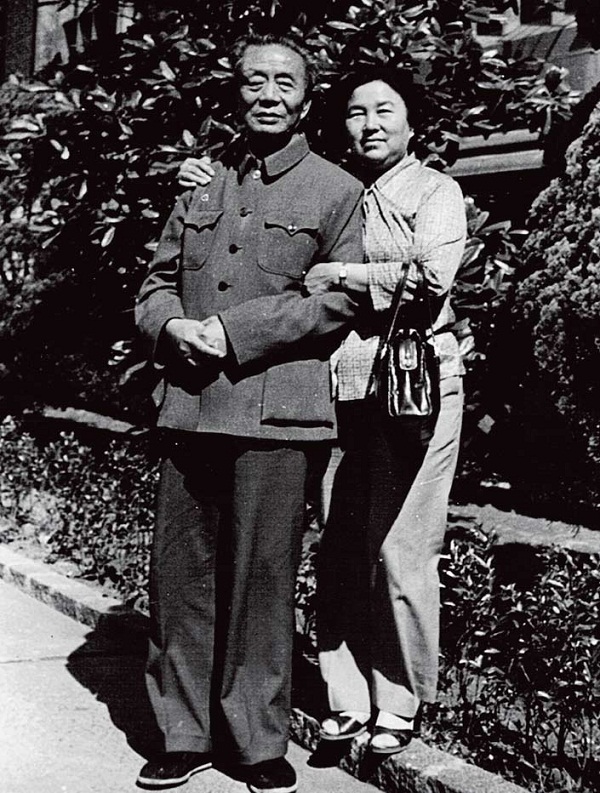
Although I had known I would be coming to see Ai Qing some days before and had even done some reading to familiarise myself with some of his later writings, I was still a little on edge about the meeting. Three years of Chinese language study in Australia, though leaving me with an adequate grasp of the basics of the language, had done little to nothing for my knowledge of Chinese writing, especially modern and contemporary literature. Much of my time in Beijing, Shanghai and Shenyang was spent trying to make up for my ignorance. Unfortunately, the years I was in China gave little opportunity to find out much of what had happened in literature prior to Jiang Qing’s ‘revolution’ of the Model Beijing Operas in 1964. The eight ‘model’ operas (model only in that in Jiang’s eyes they were to be the archetypes for all present and future Chinese literature and art) and a few imitative creations in prose, poetry and so on were the only post-1949 works we were encouraged to study, all else being bourgeois, reactionary or revisionist.
The only contact we had had with the name Ai Qing in our classes was when the teacher gave a lecture on the Hundred Flowers movement of 1956-1957. It was during this mass movement that everyone in China, regardless of political affiliation, was encouraged to express their opinions about the government and the Communist Party. Ai Qing had made the unfortunate statement that political movements in the arts had come to consist purely of ‘one group attacking another’. This comment and a few articles he wrote during this period were said to qualify him for a ‘rightist cap’ or classification during the subsequent retribution, the Anti-Rightist Campaign of 1957-1958. It is interesting that Yao Wenyuan, the ‘cultural mediator’ during the Cultural Revolution and member of the Gang of Four, rose to prominence during this period. One of Yao’s more famous essays of this time was entitled ‘Ai Qing’s Way’ [the full title of the attack was ‘Ai Qing’s Way: from democracy to anti-socialism’ 艾青的道路―—從民主主義到反社會主義], and was on our class reading list.
Now here I was faced with no common ‘rightist’, but a famous writer who had been labelled as a ‘cow demon and snake spirit’ around the time I was still learning to walk. Ai Qing had had his ‘cap taken off’, that is he was pardoned, in 1960. It was only recently that the stigma of having been one at all began to fade. I sat dumbly, my head swirling with questions. I didn’t really know where to begin. Fortunately my friend held up our end of the conversation as tea, cigarettes and sweet melon (hamigua) from Xinjiang were offered.
After a few enquiries we discovered that the authorities were in the process of restoring the poet’s family to their original house near Beijing Railway Station. Their present house, though adequate for their needs, was becoming inconvenient with the increasing number of visitors the old poet was receiving.
As I settled into a Peony cigarette, I asked the poet where he and his family had been for the last twenty years. Had they stayed in Beijing or gone back to Ai Qing’s native home, Jinhua in Zhejiang, near Shanghai? The poet’s only comment was that they, like so many others, had simply disappeared. His wife, Gao Ying, brushing this comment aside said that they had been eating freshly picked hamigua for the past twenty years!
Xinjiang?! They had been in Xinjiang all of this time? Thousands of miles from their home in the eastern provinces of China, so different to the China they had known all their lives, so far from the friends and things they were familiar with. It was few people indeed who went off to the west happily either now or in the past in China. Although the famous poet of the Tang dynasty, Li Bo, had come from Cuiye Cheng in the far west, he had never ventured back there during his later life. And few officials of the past relished the thought of banishment in far-off ‘Turfan’.
Ai Qing, seeing my shocked reaction, was quick to add that it didn’t matter what you wanted to call their sojourn in the west; they had, at least, been safe. Had they stayed in Beijing during the years of the Cultural Revolution, it is doubtful that they would still be alive today. The well-loved novelist and playwright Lao She died in 1967 owing to the unjust criticism and attacks on him by the Red Guards. Even secluded in distant Shihezi, near Urunmqi, hundreds of Ai Qing’s poems, the product of ten years of creative energy, were taken and destroyed by the Red Guards in 1967. No, he was glad they had not stayed in Beijing; the further they were away from the Gang of Four the better.
Our conversation drifted to the fate of other writers and intellectuals, so many of whom seemed to have been made into enemies and seen as a threat to the country in the past years. Ai Qing related his own history after I questioned him about how he began to write poetry. He said he originally had little thought of becoming a poet. After graduating from the West Lake Art School in Hangzhou in 1928, he went to study art in France where, working as a part-time porcelain painter, he also continued his studies. He returned to China after the invasion of Manchuria in 1931 which marked the beginning of the Sino-Japanese War, and soon became involved in the leftist art circle of Shanghai. Arrested in 1932 by the Guomindang for being a member of the Leftist Artists’ Union, he was sent to prison for four years. It was during this period of imprisonment, cut off from brush and paints, that Ai Qing began to write poetry. He found pen and paper more suited to express the frustration and anger he felt towards his unjust confinement and the genuflection of the Guomindang before the invading Japanese.
His first famous poem, Dayan He [大堰河], was smuggled out of gaol and sent to a schoolmate in 1933, whereupon it was published and won immediate acclaim as one of the greatest poems of the time. Following his release in the mid 1930s and the publication of the first collection of his poems, Jiang Haicheng, the artist, became known as Ai Qing, the poet.
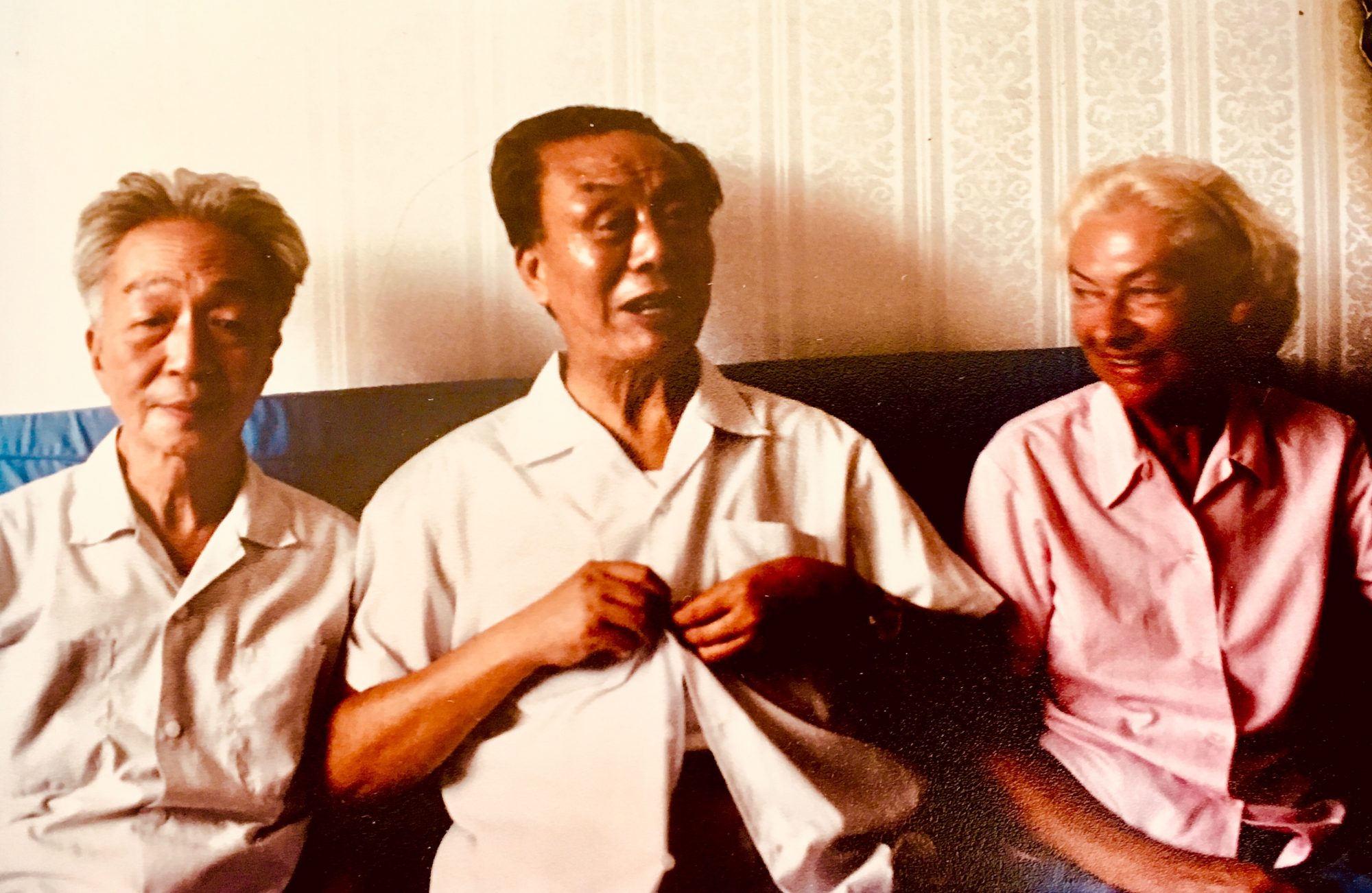
Sated now with watermelon and tea, we had another round of Peony cigarettes and the poet related how he went to Chongqing and later on to the headquarters of the Communist Party, Yan’an. In Yan’an he taught at the Lu Xun Academy of Arts and became one of the editors of the periodical Poetry. It was during this period that he wrote the later widely condemned article ‘Understand and Respect Writers’, in which he called for readers and Party leaders to be more understanding of writers and their social function. Though published thirty-five years ago, I was very familiar with this article, for it was one of the major ‘poisonous weeds’ attacked during the 1957 literary witch-hunts. Although ideologically inoffensive and marked by a common-sense approach to writers and writing, it had been published by Ding Ling, a noted novelist and critic overthrown as an anti-Party element in 1956. This association was enough to condemn Ai Qing.
As I listened to him talk, I realised how little of the truth of the literary debates in China could be seen through the black and white logic and stilted rhetoric of what passed as literary analysis and criticism in both the Chinese media and schools. Although any objective literary review was an impossibility up to the time of the arrest of the Gang of Four, it has become common since 1976 to blame all distortions and failures of policy on the seemingly omnipresent wickedness of only four Party leaders. But the state of contemporary Chinese literature and art was not the result of post-1966 excesses alone. As most older people knew and many younger ones were finding out, the dogmatism and narrowness of the Cultural Revolution period was foreshadowed in the complex political movements and struggles of 1956-1958. The literary debates and repression of this era successfully limited the range of literary and artistic expression in China. Although the Cultural Revolution allowed selected workers and peasants greater opportunities to write and be published, even the most ingenious amateur writer would be incapable of getting his works passed by Jiang Qing and Yao Wenyuan’s literary watch-dogs. The result of this was that, rather than see an honest attempt to let the working people take part in literary creation, the ‘Gang’ had destroyed all spontaneity and individuality in the arts.
While we were talking, Ai Qing took out a couple of the poems he recently had published in the Shanghai daily newspaper, Wenhui bao. As a fitting conclusion to our discussion of the ‘Gang period’ of literature, the poet read out his poem entitled The Fossil [魚化石, my translation]:
How lively you were, fish!
How full of energy!
Jumping through the waves,
Diving through the seas;
Tragic that you met with an eruption,
Though perhaps it was an earthquake.
You lost your freedom,
Buried deep in dust and rubble.
How many the aeons,
Before, discovered by
Some geologists,
Now but an image of your past.
For you are silent now,
No breath of life.
Scales and fins though intact,
You are frozen in stillness.
Your absolute passivity,
Dead to the world.
No longer can you see sky or sea,
No longer hear the breaking waves.
Even a fool can realize the truth
When he sees a fossil:
Without movement,
There is no life.
To live one must struggle,
To advance in struggle.
Even though it may mean death,
One must still strive. [See Source below]
動作多麼活潑,
精力多麼旺盛,
在浪花裡跳躍,
在大海裡浮沈。
不幸遇到火山爆發,
也可能是地震,
你失去了自由,
被埋進了灰塵。
過了多少億年,
地質勘察隊員
在岩層里發現你,
依然栩栩如生。
但你是沈默的,
連嘆息也沒有,
鱗和鰭都完整,
卻不能動彈。
你絕對的靜止,
對外界毫無反應,
看不見天和水,
聽不見浪花的聲音。
凝視著一片化石,
傻瓜也得到教訓:
離開了運動,
就沒有生命。
活著就要鬥爭,
在鬥爭中前進,
當死亡沒有來臨,
把能量發揮乾淨。
The reappearance of Ai Qing’s name in print earlier in the year had solicited an immediate and overwhelming response from readers all over the country. Letters from people who had, as one reader put it, ‘searched for the people’s poet for twenty years’, had been passed on by the Writers’ Association and other organizations in contact with Ai Qing. The effusive response of his public, and the attention and respect he was being given by the leaders of the arts, had heartened Ai Qing enough to start meeting friends freely again and, in the long run, even resulted in our encounter that day.
Although our conversation continued to ramble through some of the forgotten comers of the Chinese arts, I was worried that we had already taxed the poet too much that day. Both he and Gao Ying were quick to extend an invitation to me to go back after the poet returned from a trip to the north-eastern oilfields — a special tour organized by China’s biggest daily newspaper, the People’s Daily, for a group of writers.
Ai Qing and Gao Ying saw us out to the gate in typical Chinese fashion. Ages seem to have passed since we first stepped over the well-worn stone flags of the entrance. Indeed, we had travelled through the confused and suffering years of pre-1949 China, the enthusiastic early years of the People’s Republic and the defeats and victories of China’s years of building socialism. My only feeling and hope was that perhaps now the leadership and people of China, far wiser and more aware after the recent years of waste and suffering, will prevent another turning back of the clock of history. Perhaps in the future the talent and genius of men like Ai Qing will not be mutilated or ignored, but will be truly used for the betterment of their fellows.
The sun had not yet fallen behind the Western Hills as we made our way back along Historians’ Alley. The peace and stillness of the courtyard world that we had enjoyed for the last few hours was quickly shattered by bustling, noisy groups of people going home after work, shopping or just idling in the street talking.
***
Source:
Geremie Barmé, ‘An Afternoon in Beijing, September 1978’, a chapter in China in the Seventies: Australian Perspectives, edited by Stephen FitzGerald and Pamela Hewitt, Canberra: Contemporary China Centre, Australian National University, 1980, pp.137-146. The Chinese text of The Fossil has been added. Here I would observe that careful readers will notice a discrepancy between the added Chinese text and my translation. That is between: ‘Even though it may mean death, /One must still strive’ and 當死亡沒有來臨, / 把能量發揮乾淨. All I can suggest is that, either the hand-written version of the poem that Ai Qing gave me at the time was different from the published Chinese text, or the translation simply reflects the mood of our conversation on that autumn day and my jejune efforts at translation. If I uncover Ai Lao’s hand-written original in my long-neglected and disheveled files, I will update this note.
I am grateful to Stephen FitzGerald, Australian Ambassador to the People’s Republic of China during my student days, for suggesting that I write this essay in 1979.
A 2018 Postscript
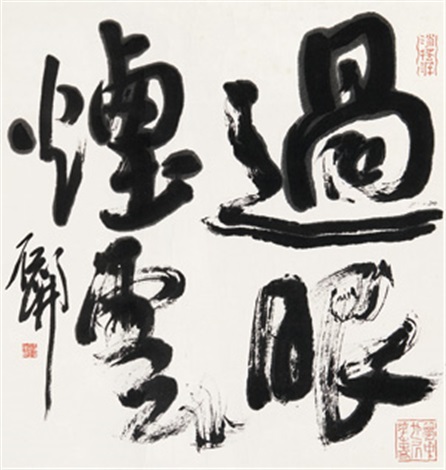
After that initial encounter in September 1978, I saw Ai Qing and Gao Ying many times over the years. We remained friendly despite our increasingly divergent view of contemporary Chinese culture, in particular poetry.
A second visit to their courtyard house in the spring of 1979 coincided with a memorable moment in the fitful flourishing of post-Mao cultural freedom. One spring morning, as Ai Qing and I were chatting, a young women on a tricycle rode up to the gate. She introduced herself as Dong Xiuyu (董秀玉, 1941-), assistant to the head of Sanlian Books 三聯書店, Fan Yong (范用, 1923-2010), whom I already knew. She gave us copies of the first issue of a new journal, simply called Reading 讀書. As the magazine was waiting on a distribution license from Xinhua Bookstore, Xiuyu was hand-delivering copies to the city’s literary figures and noted intellectuals. Over the next decade Reading would be a bastion for cultural liberalisation and quasi-independent academics (subsequently, under the direction of neo-leftists, it became more of a handmaiden to power, its decline reflected the marriage of convenience between 幫閒 and 幫兇 typical of China’s for-profit mainstream intelligentsia).
We looked through the new magazine with Gao Ying, and we were soon discussing the lead article. Written by Li Honglin (李洪林, 1935-2016), a liberal-minded Party theoretician, it was titled ‘There Should be No Forbidden Zones for Readers’ 讀書無禁區. Even though the Party was reasserting its draconian rule — an example of that was the disappearance of Wei Jingsheng — those still seemed to be relatively bright months of promise. It is sobering to consider that, forty years later, and given regime-wide censorship, Li Honglin’s modest meditation on the freedom to read appears to be out-of-sync with Xi Jinping’s New Epoch.
— GRB

